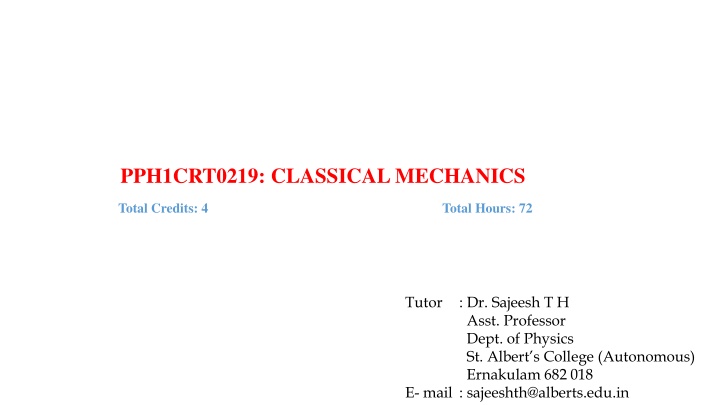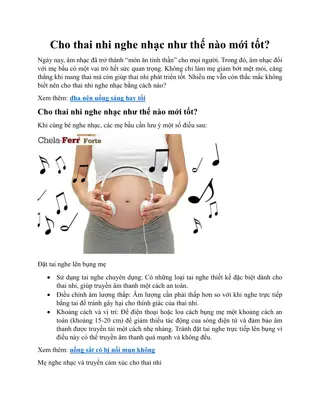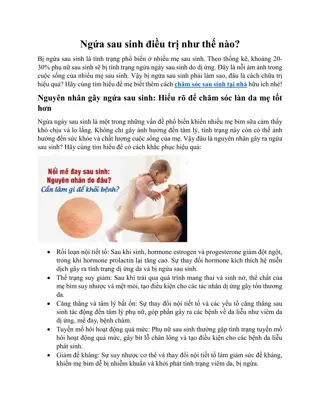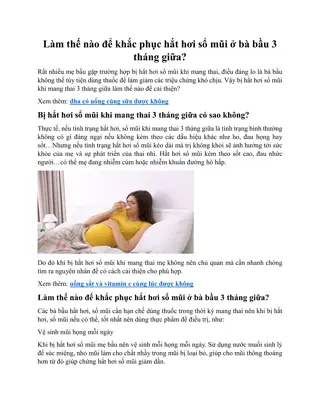
Classical Mechanics Course at St. Albert's College Ernakulam
"Explore classical mechanics concepts including Lagrangian formulation, Hamiltonian methods, small oscillations, canonical transformations, and Poisson brackets in this comprehensive course led by Dr. Sajeesh T.H., Assistant Professor at St. Albert's College, Ernakulam."
Download Presentation

Please find below an Image/Link to download the presentation.
The content on the website is provided AS IS for your information and personal use only. It may not be sold, licensed, or shared on other websites without obtaining consent from the author. If you encounter any issues during the download, it is possible that the publisher has removed the file from their server.
You are allowed to download the files provided on this website for personal or commercial use, subject to the condition that they are used lawfully. All files are the property of their respective owners.
The content on the website is provided AS IS for your information and personal use only. It may not be sold, licensed, or shared on other websites without obtaining consent from the author.
E N D
Presentation Transcript
PPH1CRT0219: CLASSICAL MECHANICS Total Credits: 4 Total Hours: 72 Tutor : Dr. Sajeesh T H Asst. Professor Dept. of Physics St. Albert s College (Autonomous) Ernakulam 682 018 E- mail : sajeeshth@alberts.edu.in
Objective of the course: After completing the course, the students will (i) understand the fundamental concepts of the Lagrangian and the Hamiltonian methods and will be able to apply them to various problems; (ii) understand the physics of small oscillations and the concepts of canonical transformations and Poisson brackets ; (iii) understand the basic ideas of central forces and rigid body dynamics; (iv) understand the Hamilton-Jacobi method and the concept of action-angle variables. This course aims to give a brief introduction to the Lagrangian formulation of relativistic mechanics.
UNIT 1 Lagrangian formulation (14 hrs) 1.1 Review of Newtonian Mechanics: Mechanics of a Particle; Mechanics of a System of Particles; Constraints; 1.2 D Alembert s principle and Lagrange s equations; velocity-Dependent potentials and the Dissipation Function; Lagrangian for a charged particle in electromagnetic field; 1.3 Application of Lagrange s equation to: motion of a single particle in Cartesian coordinate system and plane polar coordinate system; bead sliding on a rotating wire.1.4 Hamilton s Principle; Technique of Calculus of variations; The Brachistochrone problem. 1.5 Derivation of Lagrange s equations from Hamilton s Principle. 1.6 Canonical momentum; cyclic coordinates; Conservation laws and Symmetry properties- homogeneity of space and conservation of linear momentum; isotropy of space and conservation of angular momentum; homogeneity of time and conservation of energy; Noether s theorem(statement only; no proof is expected). Hamiltonian formulation: (4hrs) 1.7 Legendre Transformations; Hamilton s canonical equations of motion; Hamiltonian for a charged particle in electromagnetic field. 1.8 Cyclic coordinates and conservation theorems; Hamilton s equations of motion from modified Hamilton s principle
UNIT II Small oscillations (8hrs) 2.1 Stable equilibrium unstable equilibrium and neutral equilibrium; motion of a system near stable equilibrium-Lagrangian of the system and equations of motion. 2.2 Small oscillations- frequencies of free vibrations; normal coordinates and normal modes 2.3 system of two coupled pendula-resonant frequencies normal modes and normal coordinates ;free vibrations of CO2 molecule- resonant frequencies normal modes and normal coordinates. Canonical transformations and poisson brackets (10 hrs) 2.4 Equations of canonical transformations; Four basic types of generating functions and the corresponding basic canonical transformations. Examples of canonical transformations - identity transformation and point transformation. 2.5 Solution of harmonic oscillator using canonical transformations. 2. 6 Poisson Brackets ; Fundamental Poisson Brackets; Properties of Poisson Brackets 2.7 Equations of motion in Poisson Bracket form; Poisson Bracket and integrals of motion; Poisson s theorem; Canonical invariance of the Poisson bracket.
UNIT III Central force problem (9hours) 3.1 Reduction of two-body problem to one-body problem; Equation of motion for conservative central forces - angular momentum and energy as first integrals; law of equal areas 3.2 Equivalent one-dimensional problem centrifugal potential; classification of orbits. 3.3 Differential Equations for the orbit; equation of the orbit using the energy method; The Kepler Problem of the inverse square law force; Scattering in a central force field - Scattering in a Coulomb field and Rutherford scattering cross section. Rigid body dynamics (9hrs) 3.4 Independent coordinates of a rigid body; Orthogonal transformations ; Euler Angles. 3.5 Infinitesimal rotations: polar and axial vectors; rate of change of vectors in space and body frames; Coriolis effect. 3.6 Angular momentum and kinetic energy of motion about a point; Inertia tensor and the Moment of Inertia; Eigenvalues of the inertia tensor and the Principal axis transformation . 3.7 Euler equationsof motion; force free motion of a symmetrical top.
UNIT IV Hamilton-Jacobi theory and action-angle variables(12 hrs) 4.1 Hamilton-Jacobi Equation for Hamilton s Principal Function; physical significance of the principal function. 4.2 Harmonic oscillator problem using the Hamilton-Jacobi method. Hamilton-Jacobi Equation for Hamilton s characteristic function 4.3 Separation of variables in the Hamilton-Jacobi Equation; Separability of a cyclic coordinate in Hamilton-Jacobi equation; Hamilton-Jacobi equation for a particle moving in a central force field(plane polar coordinates) . 4.4 Action-Angle variables; harmonic oscillator problem in action-angle variables. Classical mechanics of relativity ( 6 hrs.) 4.5 Lorentz transformation in matrix form; velocity addition; Thomas precession. 4.6 Lagrangian formulation of relativistic mechanics; Application of relativistic Lagrangian to (i)motion under a constant force (ii) harmonic oscillator and (iii) charged particle under constant magnetic field.
Recommended Text Books 1. Classical Mechanics: Herbert Goldstein , Charles Poole and John Safko, (3/e); Pearson Education. 2. Classical Mechanics: G. Aruldhas, Prentice Hall 2009. Recommended References: 1. Theory and Problems of Theoretical Mechanics (Schaum Outline Series): Murray R. Spiegel, Tata McGraw-Hill 2006. 2. Classical Mechanics : An Undergraduate Text: Douglas Gregory, Cambridge University Press. 3. Classical Mechanics: Tom Kibble and Frank Berkshire, Imperial College Press. 4. Classical Mechanics ( Course of Theoretical Physics Volume 1): L.D. Landau and E.M. Lifshitz, Pergamon Press. 5. Analytical Mechanics: Louis Hand and Janet Finch, Cambridge University Press. 6. Classical Mechanics: N.C.Rana and P. S. Joag, Tata Mc Graw Hill. 7. Classical Mechanics: J.C. Upadhyaya, Himalaya Publications, 2010. 8. www.nptelvideos.in/2012/11/classicalphysics.html.






















